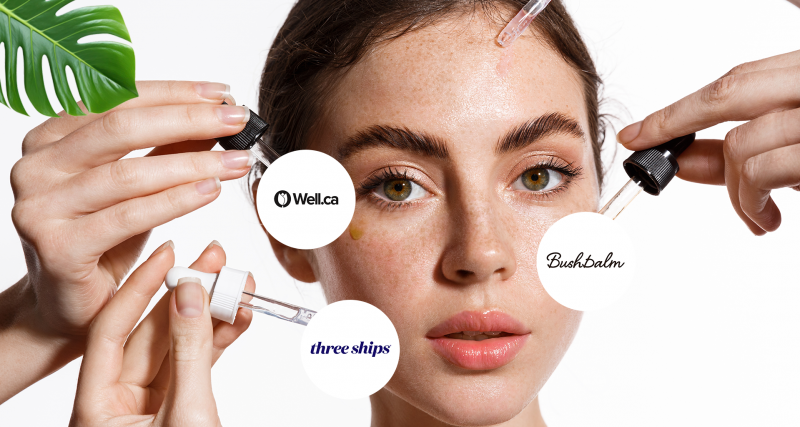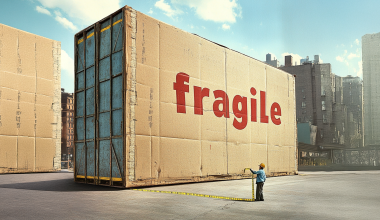The concept of clean cosmetics is a worldwide trend in the beauty industry, including in Canada. The demand for clean or organic cosmetics beauty is soaring because they are made with natural ingredients and toxin-free.
Due to the increasing awareness of the damaging effects of certain ingredients in conventional skincare and cosmetics, more Canadians are rooting for clean cosmetics. According to Statista, in 2025, the Canadian Natural Cosmetics market generated revenue amounting to US$143.43 million. Additionally, further projections indicate that the market is expected to grow at a CAGR of 4.02% between 2025 and 2030.
The commitment of the Canadian beauty industry to green and eco-friendly beauty is evident in its emphasis on ethical sourcing, sustainability, and transparent manufacturing processes.
An important part of the natural cosmetics industry is logistics. Clean cosmetics shipping in Canada has become much more than just logistics; it’s a crucial element of the customer’s overall brand experience, influencing trust and retention.
Efficient and reliable shipping develops customer confidence and satisfaction, while poor shipping experiences can damage a brand’s reputation and lead to lost customers.
This write-up will delve into cosmetic shipping packaging, eco-friendly beauty shipping, and provide fragile product shipping tips, and more.
Fragile but Fabulous — Packaging Matters More Than Ever
Packaging in glass bottles, glass droppers, and eco-containers is popularly used for their durability, aesthetics, and eco-friendliness. Glass packaging is used in a wide range of industries, from food and beverages to cosmetics.
Although glass packaging offers several advantages, there are also some risks associated with its use. Business owners and shippers need to understand these risks and make an informed decision before using glass packaging.
To counter the risks of using glass bottles, filler-free packaging has emerged as an ideal option.
Filler-free packaging for shipping focuses on using materials that reduce or eliminate the need for conventional void fill like packing peanuts or bubble wrap, while still protecting the items during logistics.
Some of the ideal ways to keep the shipped items safe are using small and sturdy packaging in shock-absorbing containers, placing the products strategically, and using sustainable materials.
Here are some more tips for achieving filler-free shipping:
1. Optimum Packaging Design:
Fit-to-size boxes: Using shipping boxes that closely match the size of the items minimizes space and the need for additional filler.
Placing items: Arranging or placing items carefully within the box to prevent movement and reduce the risk of damage is important.
Stabilizing items with supports: Using cardboard inserts, dividers, or custom-fit packaging can stabilize items and minimize the need for loose fill.
2. Alternatives for Sustainable Void Fill:
Kraft paper: It is a strong, durable, and recyclable paper that is useful to wrap items or fill empty spaces.
Recycled paper: One type of shredded or rolled paper that can be an effective void fill, and is easily recyclable.
Honeycomb paper: A type of paper that expands and interlocks to create a cushioning effect, offering sustainable options to plastic bubble wrap.
Biodegradable packing peanuts: These peanuts dissolve in water or decompose naturally, and an eco-friendly option than traditional polystyrene peanuts.
Air pillows: While technically a type of void fill, air pillows may prove to be a more sustainable option if made from recyclable or biodegradable materials.
Crinkle paper: This paper is designed to fill gaps and provide cushioning while also adding an aesthetic appeal to the packaging.
3. Other Things to Consider:
Selecting product: Selecting items that are less prone to damage during transit can reduce the need for extensive void fill.
Fragility: For fragile or delicate items, you can think of using a combination of sturdy packaging and internal supports to ensure safe delivery.
By combining these strategies, businesses can minimize waste and create a more sustainable shipping experience without compromising product protection.
Fragrance in Transit — How to Avoid Leaks, Spillages & Reactions
While shipping fragrance items, it is crucial to avoid leaks, spillages, and reactions. This is where the regulations of volatile organic compounds (VOCs) and customs come into play. This involves minimizing VOC emissions during handling, using proper packaging and storage, and ensuring adequate ventilation.
Minimizing VOC Emissions:
Controlling the Source: Use low-VOC or VOC-free fragrance formulations whenever possible. When shipping products with VOCs, ensure there is proper ventilation.
Packaging: Package fragrance products carefully, especially those with high VOC content, because containers are enclosed where leakage or spillages can cause problems.
Handling: Use best practices during loading and unloading items, such as using closed-loop systems for tank venting and proper cargo handling procedures.
Secure Packaging: Use the right durable packaging materials that can withstand potential leaks and spills during shipping.
Leak Prevention: Ensure containers have leak-proof seals to prevent any leakage of fragrance materials.
Material Compatibility: Choose packaging materials that are compatible with the fragrance ingredients to prevent reactions and degradation.
Vapor Emission Control Systems (VECS): Consider using VECS to capture VOCs during loading and unloading items, preventing them from being released into the atmosphere.
Customs Requirements:
Shipping fragrances to Canada involves specific customs requirements due to their classification as hazardous goods (Class 3 Flammable Liquids).
Key Requirements:
Declare Ingredients: When shipping fragrances, you need to declare ingredients on the product label, following cosmetic regulations. This includes listing all ingredients using their INCI names in descending order of predominance.
Hazardous Goods Classification: Perfumes containing alcohol are classified as dangerous goods due to their flammability.
MSDS: A Material Safety Data Sheet (MSDS) is crucial. It provides details about the perfume’s composition, including flashpoint and alcohol content.
Documentation: Accurate documentation, including the UN number, proper shipping name, and hazard classification, is essential for customs and carrier compliance.
Carrier Regulations: The selected carrier must be authorized to handle dangerous goods and be familiar with the relevant regulations.
Canadian customs will assess duties and taxes based on the value of the shipment.
Regulations: There are certain shipping regulations for cosmetics in Canada. Importers of cosmetic products (including fragrances) need to notify Health Canada within 10 days of the first sale.
Restrictions: Some ingredients may be prohibited or restricted in Canada.
IATA/IMO Regulations: The International Air Transport Association (IATA) and the International Maritime Organization (IMO) Regulations have set regulations for shipping hazardous goods.
Express Shipping: Express shipping can be useful for temperature-sensitive fragrances and to minimize shipping time.
Possible Delays: Non-compliance with regulations can lead to delays, rejection of the shipment, or penalties.
Importer Responsibilities: The importer is responsible for ensuring that the shipped items comply with all Canadian regulations, including labeling and notification requirements.
Shipping fragrances to Canada needs careful attention to detail. It ensures compliance with dangerous goods regulations, proper packaging, accurate documents, and compliance with carrier and customs regulations.
Speed + Sustainability: Getting It There Fast Without the Waste
For affordable shipping within Canada, Canada Post and FedEx Ground often offer competitive rates.
Canada Post is generally more affordable for smaller, lighter packages, and FedEx Ground is potentially better for larger, heavier items or shipments going further distances.
Here’s more comparison:
Cost:
Canada Post: Usually offers lower rates for small, lightweight packages, especially within Canada. They have services like “Canada Post Expedited Parcel” which can be affordable for regional and national shipping with a reasonable delivery time.
FedEx Ground: This can be more cost-effective for heavier packages, especially for longer distances within Canada. Their “FedEx Ground” service is an ideal option if you are not looking for super-fast delivery but want a reliable and trackable shipping service.
Speed:
Canada Post: Delivery times of Canada Post vary, but they offer options like “Xpresspost” (next-day or 2-day delivery depending on distance) and “Priority” (guaranteed next-day delivery).
FedEx Ground: This shipping giant typically delivers within 1-5 business days within Canada, while “FedEx Ground Economy” can take longer (2-7 business days). They also offer faster options like “FedEx 2Day” and “FedEx Standard Overnight” for faster delivery.
ShippingChimp: ShippingChimp offers 1 day or 2 day delivery across Canada and shipping rates start at $5.11. Additionally, pick up is free of charge.
Regional fulfillment centers are crucial for faster last-mile delivery by logistics companies like Canada Post, FedEx Ground, and ShippingChimp. By strategically locating inventory closer to customers, these centers reduce transit times and improve delivery speed.
Here’s a more detailed look:
Canada Post:
Canada Post employs a network of fulfillment centers in key Canadian regions (e.g., Scarborough, Aurora, Whitby, Brampton, etc.) to bring inventory closer to customers. This “local-to-local” approach minimizes transit time and reduces reliance on traditional postal hubs.
FedEx Ground:
FedEx Ground uses regional sortation facilities to serve as direct injection points for large e-commerce customers. This allows them to bypass the main sortation hub and deliver packages more quickly to customers.
Sustainability:
A sustainable packaging strategy is an approach that aims to reduce the negative environmental and social impacts of packaging.
This can involve assessing the lifecycle of packaging material options and the availability of waste and recycling infrastructure to process waste materials.
To achieve eco-packaging goals with speed, focus on implementing strategies that leverage recycled materials and efficient processes.
Prioritize using recycled content in packaging, like recycled paper or cardboard for boxes, and consider alternatives like mushroom packaging for insulation.
Here’s how to maintain eco-packaging goals with speed:
1. Recycled Content and Efficient Processes:
Use Recycled Materials: Use recycled content in packaging materials such as recycled paper, cardboard, or even options like mushroom packaging for insulation.
Streamline Packaging Design: Reduce the size and complexity of packaging to minimize material usage and waste.
Optimize Shipping: Consolidate shipments, use efficient packaging configurations, and explore options like “ship-in-product” packaging to minimize the overall environmental impact of transportation.
2. Implement Sustainable Practices:
Source Renewable Materials: Explore options like plant-based plastics or wheat straw fiber for packaging, aligning with your budget and ESG goals.
Choose Sustainable Adhesives: Select easily separated and sustainable adhesives to help in recycling and material separation.
Label Clearly for Recycling: Ensure clear labeling to guide consumers in proper recycling or composting of packaging materials.
Consider Return, Refill, and Reuse Programs: Try options for customers to return, refill, or reuse packaging, extending the life cycle of materials.
3. Focus on Speed and Efficiency:
Automate Packaging Processes: Implement automated systems for packaging to speed up the process and improve efficiency.
Virtual Sampling: Use virtual sampling to reduce material waste associated with physical prototypes during packaging design.
Optimize Storage: Ensure efficient storage of packaging materials to minimize waste and maximize space utilization.
4. Measure and Improve:
Track Packaging Performance: Monitor key metrics like packaging weight, recycled content, and recyclability rate to assess progress and identify areas for improvement.
Regularly Review and Update:
Periodically review your sustainable packaging strategy and update it based on new technologies, materials, and industry best practices.
Canadian Clean Beauty Brands Doing It Right
Here are the short profiles of a few leading Canadian brands:
Bushbalm:
A Canadian clean beauty brand Bushbalm excels in intimate skincare by focusing on addressing common concerns like ingrown hairs, razor burn, and dark spots through effective product formulations and a strong fulfillment strategy.
The company has built a community around its products by prioritizing a reliable fulfillment process that ensures timely delivery and customer satisfaction.
Three Ships:
Another Canadian skincare brand Three Ships Beauty has made its name by prioritizing natural ingredients, eco-friendly packaging, and transparent business practices. The brand is certified cruelty-free, meaning they do not test their products on animals.
Well.ca
Well.ca takes proactive measures to ensure customers receive their deliveries as smoothly as possible. The company ships the items of clean indie brands with scale.
Most Well.ca orders are delivered within 2-5 days, depending on stock availability, warehouse location, and shipping destination. For orders costing $35 and above within Canada, they offer free shipping. For orders below $35, a shipping fee applies.
FAQs
Q: How do you ship fragile cosmetic products from Canada?
Ans: To ship fragile cosmetic products from Canada, use durable, right-sized boxes, wrap the items with bubble wrap or foam, and cushion the interior with packing peanuts, air pillows, or crumpled paper. Also, clearly label the box with “Fragile”.
Q: Are there shipping restrictions on cosmetics in Canada?
Ans: There are shipping restrictions for cosmetics in Canada. Cosmetics sold in Canada have to comply with Health Canada’s Cosmetic Regulations, which cover manufacturing, packaging, storage, importation, sales, and labeling.
Q: How do Canadian D2C brands handle returns on beauty products?
Ans: Canadian D2C beauty brands usually handle returns by providing a clear return policy, which you can view on an online portal.
Also, efficient reverse logistics, accurate inventory updates, and inspection of returned items are key elements of their returns management.
Before We Go
Canadians prefer clean cosmetics practices because they understand the significance of cruelty-free and chemical-free skincare products.
The importance of supporting brands that align with their values and promote ethical practices by choosing cruelty-free beauty and vegan cosmetics cannot be overstated.
By opting for chemical-free skincare and all-natural beauty products, Canadians can reduce their exposure to harmful toxins, thus safeguarding their health and well-being.
When it comes to fast shipping, build your clean shipping workflow with ShippingChimp. Let’s make your products look as good when they arrive as they do on your Instagram.
- Why Winter Shipping Is a Big Deal for D2C Cosmetics Brands? - December 18, 2025
- The Last Minute Customer Strategy: Handling Orders After the Carrier Cut-off - December 12, 2025
- Holiday Shipping Deadlines 2025: When to Ship for On-Time Christmas Delivery - December 3, 2025






